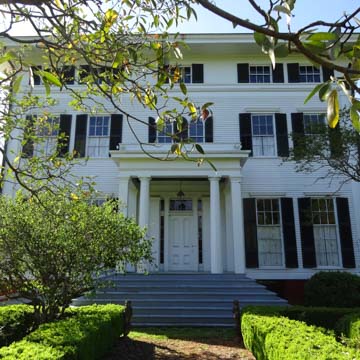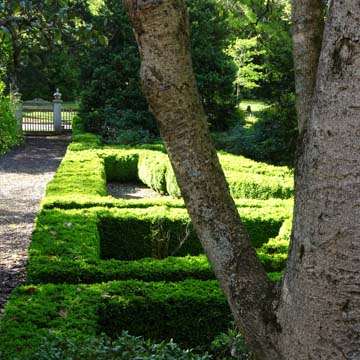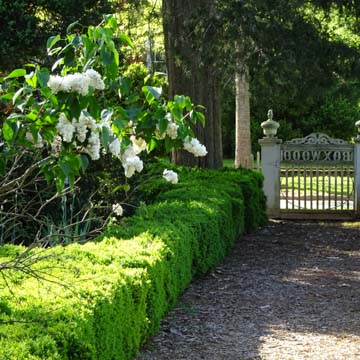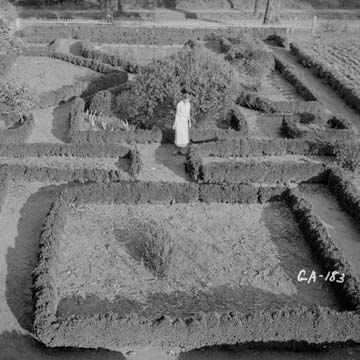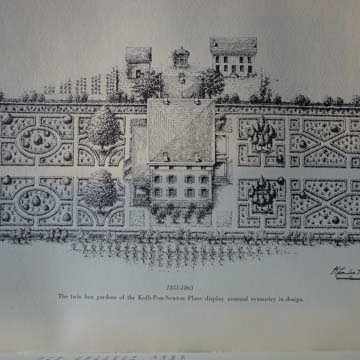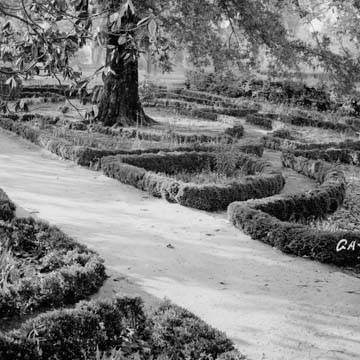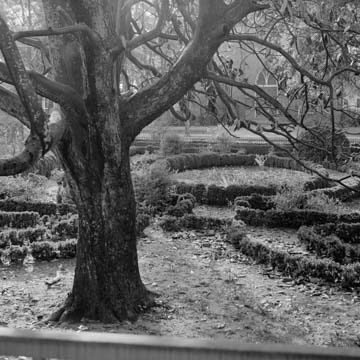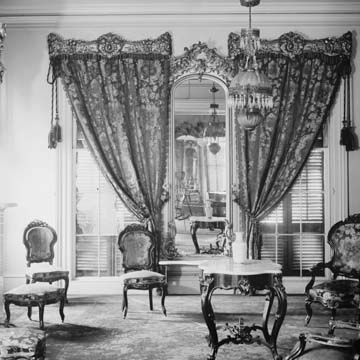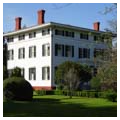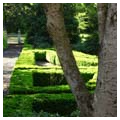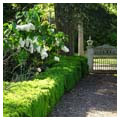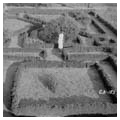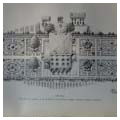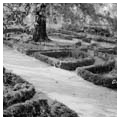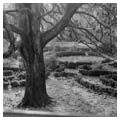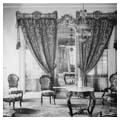You are here
Kolb-Newton House
Sited along Old Post Road amidst antebellum residences on ample lots, the Kolb-Newton House is especially noted for its historic boxwood garden, one of the best-preserved antebellum gardens in Georgia. Built by Wildes Kolb, this house retains a mixture of emerging Italianate forms and Greek Revival detail typical of its midcentury antebellum date. Its basic massing recalls the cubic block form and two-and-a-half-story elevation of Federal architecture. The single-story Doric porch on the elevation facing Old Post Road utilizes piers at the corner, and columns in antis recall the popular distyle in antis composition of contemporary Greek Revival design. The veranda on the opposite facade, along what is now Academy Street, recalls Design VIII for a suburban cottage in the Italian mode illustrated in Andrew Jackson Downing’s pattern book, The Architecture of Country Houses(1850). Other features evidencing the emerging Italian taste are the rounded windows above the veranda and Doric porch, the broad overhanging eave (although here unbracketed), and the Italianate marble mantels on the interior. The large house occupies its ample site, which allowed for two outbuildings: slaves’ quarters and a smokehouse.
The town of Madison was founded in 1809 and named for the newly elected fourth president of the United States, James Madison. Its architecture soon displayed a stylish character contributing to a cultured community, but one which remained rural and with an economy based first on subsistence farming but by the 1840s increasingly on cotton. The county’s high production of cotton averaged twelve to fourteen thousand bales of cotton per year. Transportation to markets, and Madison’s connection to prominent Georgia cities, was also enhanced by the arrival of the railroad, originally projected to be a spur line from the main route from Augusta through Athens to Terminus (the future Atlanta), but by 1839 Madison was on the main line connecting Augusta to Terminus. During General William Tecumseh Sherman’s 1864 March to the Sea, Union forces burned down Madison’s commercial and industrial buildings but antebellum houses, like Kolb House, were spared.
The house was sold to Louis W. Pou in 1869 and acquired in 1906 by John T. Newton, whose family still maintains the house and garden. The original English border box was planted about 1854. As parts of the ornamental hedge die out, rooted cuttings are maintained to replace individual boxwoods so that the entire parterre derives from the original stock. This, and various native plantings on the grounds, are considered heirloom plants in keeping with the period of the house, making Boxwood one of the most remarkably intact historic houses and gardens of the period in Georgia. A rose garden adorns the center of the side yard; it is surrounded by open lawn and bordered by hydrangeas, white-flowering quince, pearl bush, flowering almond shrub, and native azaleas. The edge of the field is lined with ginkgoes and figs. One of the property’s prize plants is the Franklinia alatamaha, discovered in 1765 along the Altamaha River by the famous botanists and travelers William and John Bartram. William Bartram gathered seeds (it is no longer found in the wild), cultivated the plant in the Bartram garden in Philadelphia, and named it for Benjamin Franklin and for the southeastern river he misspelled.
The grounds include a host of trees, shrubs, and native flowers such as a flowering deciduous shrub (smoke tree) along the entry path, the Grancy Graybeard bordering the side yard, a Chinese Kousa dogwood, a scented American tea olive (one of the largest in the area), a Carolina allspice, the wildflower Queen Anne’s lace, and wood hyacinth or Scilla, an old flower that Newton brought to Madison from Griffin. Other plants include purple Buddleia to attract butterflies; forsythia, which paints a bright yellow in early spring; and the fragrant white-flowered mock-orange shrub. Finally, the garden is also adorned with hollyhocks, daylilies, old petunias, lilac, weigela, and the herbs rosemary, lavender, and thyme.
A trip to Madison is a sojourn back in time, and a stroll through the historic garden of Boxwood is especially so.
References
Mitchell, William R. Madison: A Classic Southern Town. Savannah, GA: Golden Coast Pub, 2009.
McCrady, Allyson. “An Antebellum Garden with Deep Southern Roots.” Garden and Gun, Summer 2007.
Writing Credits
If SAH Archipedia has been useful to you, please consider supporting it.
SAH Archipedia tells the story of the United States through its buildings, landscapes, and cities. This freely available resource empowers the public with authoritative knowledge that deepens their understanding and appreciation of the built environment. But the Society of Architectural Historians, which created SAH Archipedia with University of Virginia Press, needs your support to maintain the high-caliber research, writing, photography, cartography, editing, design, and programming that make SAH Archipedia a trusted online resource available to all who value the history of place, heritage tourism, and learning.














